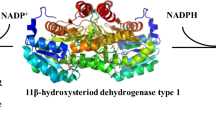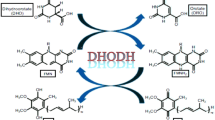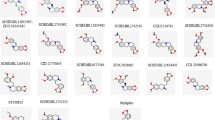Abstract
Purpose
The current study is aimed to perform structure-based screening of FDA-approved drugs that can act as novel inhibitor of the 11beta- hydroxysteroid dehydrogenase type 1 (11β-HSD1) enzyme.
Methods
Structural analogs of carbenoxolone (CBX) were selected from DrugBank database and their Absorption, Distribution, Metabolism, Excretion, and Toxicity (ADMET) parameters were investigated by SwissADME. Molecular docking of CBX analogs against 11β-HSD1 was performed by AutoDock tool, their binding patterns were visualized using PyMOL and the interacting amino acids were determined by ProteinPlus tool. Molecular dynamics simulation was performed on the docked structure of 11β-HSD1 (Protein Data Bank (PDB) code: 2ILT) using GROMACS 2018.1.
Results
The binding energies of hydrocortisone succinate, medroxyprogesterone acetate, testolactone, hydrocortisone cypionate, deoxycorticosterone acetate, and hydrocortisone probutate were lower than that of substrate corticosterone. The molecular dynamics simulation of 11β-HSD1 and hydrocortisone cypionate docked structure showed that it formed a stable complex with the inhibitor. The Root mean square deviation (RMSD) of the protein (0.37 ± 0.05 nm) and ligand (0.41 ± 0.06 nm) shows the stability of the ligand-protein interaction.
Conclusion
The docking study revealed that hydrocortisone cypionate has a higher binding affinity than carbenoxolone and its other analogs. The molecular dynamics simulation indicated the stability of the docked complex of 11β-HSD1 and hydrocortisone cypionate. These findings indicate the potential use of this FDA approved drug in the treatment of type 2 diabetes. However, validation by in vitro inhibitory studies and clinical trials on type 2 diabetes patients is essential to confirm the current findings.






(Source: Zinc15 database)


(Source: PyMOL and ProteinPlus)

Similar content being viewed by others
Abbreviations
- ADMET:
-
Absorption, Distribution, Metabolism, Excretion, and Toxicity
- 11β-HSD1:
-
11beta-Hydroxysteroid Dehydrogenase Type 1
- CBX:
-
Carbenoxolone
- 2D:
-
Two Dimensional
- 3D:
-
Three Dimensional
- dt:
-
Step Size
- Elec:
-
Electrostatic
- FDA:
-
Food and Drug Administration
- GC:
-
Glucocorticoid
- HBA:
-
Number of Hydrogen Bond Acceptors
- HbA1c:
-
Glycated Hemoglobin
- HBond:
-
Hydrogen Bond
- HOMA-IR:
-
Homeostatic Model Assessment for Insulin Resistance
- HTN:
-
Hypertension
- IR:
-
Insulin Resistance
- LogP:
-
Logarithmic Octanol Water Partition Coefficient
- MD:
-
Molecular Dynamics
- metS:
-
Metabolic Syndrome
- MM-PBSA:
-
Molecular Mechanics Poisson–Boltzmann Surface Area.
- MW:
-
Molecular Weight
- nats:
-
Number of Atoms
- nrotb:
-
Number of Rotatable Bonds
- ns:
-
Number of Steps
- n violations:
-
Number of Violations
- NCBI:
-
National Center for Biotechnology Information
- NPT:
-
Constant Number of Atoms, Pressure, and Temperature
- NVT:
-
Constant Number of Atoms, Volume, and Temperature
- PDB:
-
Protein Data Bank
- RMSD:
-
Root Mean Square Deviation
- SDF:
-
Spatial Data File
- T2D:
-
Type 2 Diabetes
- TIP3P:
-
Transferable Intermolecular Potential with 3 Points
- TPSA:
-
Topological Polar Surface Area
- Vol:
-
Volume
- VDW:
-
Van Der Waals
References
Barbot M, Ceccato F, Scaroni C. Diabetes Mellitus secondary to Cushing’s Disease. Front Endocrinol (Lausanne). 2018;9:284.
Steffensen C, Dekkers OM, Lyhne J, Pedersen BG, Rasmussen F, Rungby J, et al. Hypercortisolism in newly diagnosed type 2 diabetes: a prospective study of 384 newly diagnosed patients. Horm Metab Res. 2019;51:62–8.
Aulinas A, Valassi E, Webb SM. Prognosis of patients treated for Cushing syndrome. Endocrinol Nutr. 2014;61(1):52–61.
Tomlinson JW, Walker EA, Bujalska IJ, Draper N, Lavery GG, Cooper MS, et al. 11β-Hydroxysteroid dehydrogenase type 1: a tissue-specific regulator of glucocorticoid response. Endocr Rev. 2004;2:831–66.
Peng K, Pan Y, Li J, Khan Z, Fan M, Yin H, et al. 11β-Hydroxysteroid dehydrogenase type 1(11β-HSD1) mediates insulin resistance through JNK activation in adipocytes. Sci Rep. 2016;6:37160.
Thomas MP, Potter BV. Crystal structures of 11β-hydroxysteroid dehydrogenase type 1 and their use in drug discovery. Future Med Chem. 2011;3(3):367–90.
Morgan SA, Gathercole LL, Hassan-Smith ZK, Tomlinson J, Stewart PM, Lavery GG. 11β-HSD1 contributes to age-related metabolic decline in male mice. J Endocrinol. 2022;255(3):117–29.
Garcia RA, Search DJ, Lupisella JA, Ostrowski J, Guan B, Chen J, et al. 11β-hydroxysteroid dehydrogenase type 1 gene knockout attenuates atherosclerosis and in vivo foam cell formation in hyperlipidemic apoE-/- mice. PLoS ONE. 2013;8(2):e53192.
Morton NM, Holmes MC, Fievet C, Staels B, Tailleux A, Mullins JJ, et al. Improved lipid and lipoprotein profile, hepatic insulin sensitivity, and glucose tolerance in 11beta-hydroxysteroid dehydrogenase type 1 null mice. J Biol Chem. 2001;276(44):41293–300.
Almeida C, Monteiro C, Silvestre S. Inhibitors of 11β-Hydroxysteroid dehydrogenase type 1 as potential drugs for type 2 diabetes Mellitus—A systematic review of clinical and in vivo preclinical studies. Sci Pharm. 2021;89(1):5.
Anil TM, Dandu A, Harsha K, Singh J, Shree N, Kumar VS, et al. A novel 11β-hydroxysteroid dehydrogenase type1 inhibitor CNX-010-49 improves hyperglycemia, lipid profile and reduces body weight in diet induced obese C57B6/J mice with a potential to provide cardio protective benefits. BMC Pharmacol Toxicol. 2014;15:43.
Devang N, Adhikari P, Nandini M, Satyamoorthy K, Rai PS. Effect of licorice on patients with HSD11B1 gene polymorphisms- a pilot study. J Ayurveda Integr Med. 2021;12:131–5.
Guan H, Wang Y, Li H, Zhu Q, Li X, Liang G, et al. 5-Bis-(2,6-difluoro-benzylidene) Cyclopentanone Acts as a selective 11β-Hydroxysteroid dehydrogenase one inhibitor to treat Diet-Induced nonalcoholic fatty liver disease in mice. Front Pharmacol. 2021;12:594437.
Chen Y, Qian Q, Yu J. Carbenoxolone ameliorates insulin sensitivity in obese mice induced by high fat diet via regulating the IκB-α/NF-κB pathway and NLRP3 inflammasome. Biomed Pharmacother. 2019;115:108868.
Bianzano S, Heise T, Jungnik A, Schepers C, Scholch C, Grafe-Mody U. Safety, tolerability, pharmacokinetics and pharmacodynamics of single oral doses of BI 187004, an inhibitor of 11beta-hydroxysteroid dehydrogenase-1, in healthy male volunteers with overweight or obesity. Clin Diabetes Endocrinol. 2021;7(1):16.
Freude S, Heise T, Woerle HJ, Jungnik A, Rauch T, Hamilton B, et al. Safety, pharmacokinetics and pharmacodynamics of BI 135585, a selective 11β-hydroxysteroid dehydrogenase-1 (HSD1) inhibitor in humans: liver and adipose tissue 11β-HSD1 inhibition after acute and multiple administrations over 2 weeks. Diabetes Obes Metab. 2016;18(5):483–90.
Heise T, Morrow L, Hompesch M, Haring HU, Kapitza C, Abt M, et al. Safety, efficacy and weight effect of two 11β-HSD1 inhibitors in metformin-treated patients with type 2 diabetes. Diabetes Obes Metab. 2014;16(11):1070–7.
Liu W, Katz DA, Locke C, Daszkowski DJ, Wang Y, Rieser MJ, et al. Clinical safety, pharmacokinetics, and pharmacodynamics of the 11β-hydroxysteroid dehydrogenase type 1 inhibitor ABT-384 in healthy volunteers and elderly adults. Clin Pharmacol Drug Dev. 2013;2:133–51.
Wright DH, Stone JA, Crumley TM, Wenning L, Zheng W, Yan K, et al. Pharmacokinetic-pharmacodynamic studies of the 11β-hydroxysteroid dehydrogenase type 1 inhibitor MK-0916 in healthy subjects. Br J Clin Pharmacol. 2013;76(6):917–31.
Shah S, Hermanowski-Vosatka A, Gibson K, Ruck RA, Jia G, Zhang J, et al. Efficacy and safety of the selective 11β-HSD-1 inhibitors MK-0736 and MK-0916 in overweight and obese patients with hypertension. J Am Soc Hypertens. 2011;5(3):166–76.
Rosenstock J, Banarer S, Fonseca VA, Inzucchi SE, Sun W, Yao W, et al. INCB13739-202 principal investigators. The 11-beta-hydroxysteroid dehydrogenase type 1 inhibitor INCB13739 improves hyperglycemia in patients with type 2 diabetes inadequately controlled by metformin monotherapy. Diabetes Care. 2010;33(7):1516–22.
Armanini D, Karbowiak I, Krozowski Z, Funder JW, Adam WR. The mechanism of mineralocorticoid action of carbenoxolone. Endocrinology. 1982;111(5):1683–6.
Andrews RC, Rooyackers O, Walker BR. Effects of the 11 beta-hydroxysteroid dehydrogenase inhibitor carbenoxolone on insulin sensitivity in men with type 2 diabetes. J Clin Endocrinol Metab. 2003;88(1):285–91.
National Center for Biotechnology Information. PubChem Compound Summary for CID 636403, Carbenoxolone. 2022. https://pubchem.ncbi.nlm.nih.gov/compound/636403. Accessed 4 Aug. 4 2022.
Wang Y, Bryant SH. The NCBI Handbook. 2nd ed. NCBI PubChem BioAssay Database; 2014.
wwPDB consortium. Protein Data Bank: the single global archive for 3D macromolecular structure data. Nucleic Acids Res. 2019;47:D520–8.
Wishart DS, Knox C, Guo AC, Shrivastava S, Hassanali M, Stothard P, et al. DrugBank: a comprehensive resource for in silico drug discovery and exploration. Nucleic Acids Res. 2006;34:D668–72.
Kim S, Thiessen PA, Cheng T, Zhang J, Gindulyte A, Bolton EE. PUG-View: programmatic access to chemical annotations integrated in PubChem. J Cheminform. 2019;11(1):56.
Mooers BH. Simplifying and enhancing the use of PyMOL with horizontal scripts. Protein Sci. 2016;25(10):1873–82.
Ertl P, Rohde B, Selzer P. Fast calculation of molecular polar surface area as a sum of fragment-based contributions and its application to the prediction of drug transport properties. J Med Chem. 2000;43:3714–7.
Daina A, Michielin O, Zoete V. SwissADME: a free web tool to evaluate pharmacokinetics, drug-likeness and medicinal chemistry friendliness of small molecules. Sci Rep. 2017;7:42717.
Trott O, Olson AJ. AutoDock Vina: improving the speed and accuracy of docking with a new scoring function, efficient optimization, and multithreading. J Comput Chem. 2010;31(2):455–61.
“Open-Source PyMOL”. Schrodinger, Inc. 5 November 2021. Retrieved 7 November 2021.
Fahrrolfes R, Bietz S, Flachsenberg F, Meyder A, Nittinger E, Otto T, et al. ProteinsPlus: a web portal for structure analysis of macromolecules. Nucleic Acids Res. 2017;45(W1):W337–43.
Hsu KC, Chen YF, Lin SR, Yang JM. iGEMDOCK: a graphical environment of enhancing GEMDOCK using pharmacological interactions and post-screening analysis. BMC Bioinformatics. 2011;12:33.
Sorensen B, Winn M, Rohde J, Shuai Q, Wang J, Fung S, et al. Adamantane sulfone and sulfonamide 11-beta-HSD1 inhibitors. Bioorg Med Chem Lett. 2007;17(2):527–32.
Abraham MJ, Murtola T, Schulz R, Pall S, Smith JC, Hess B, et al. GROMACS: high performance molecular simulations through multi-level parallelism from laptops to supercomputers. SoftwareX. 2015;1–2:19–25.
Zoete V, Cuendet MA, Grosdidier A, Michielin O. SwissParam, a fast Force Field Generation Tool for Small Organic Molecules. J Comput Chem. 2011;32(11):2359–68.
Kumari R, Kumar R, Open Source Drug Discovery Consortium, Lynn A. g_mmpbsa–aGROMACS tool for high-throughput MM-PBSA calculations. J Chem Inf Model. 2014;54(7):1951–62.
Kupczyk D, Bilski R, Kozakiewicz M, Studzinska R, Kedziora-Kornatowska K, Kosmalski T, et al. 11β-HSD as a New Target in Pharmacotherapy of Metabolic Diseases. Int J Mol Sci. 2022;23:8984.
Stewart PM, Wallace AM, Atherden SM, Shearing CH, Edwards CR. Mineralocorticoid activity of carbenoxolone: contrasting effects of carbenoxolone and liquorice on 11 beta-hydroxysteroid dehydrogenase activity in man. Clin Sci (Lond). 1990;78:49–54.
Dhanesha N, Joharapurkar A, Shah G, Kshirsagar S, Dhote V, Sharma A, et al. Inhibition of 11β-hydroxysteroid dehydrogenase 1 by carbenoxolone affects glucose homeostasis and obesity in db/db mice. Clin Exp Pharmacol Physiol. 2012;39(1):69–77.
Patel H, Dhangar K, Sonawane Y, Surana S, Karpoormath R, Thapliyal N, et al. In search of selective 11β-HSD type 1 inhibitors without nephrotoxicity: an approach to resolve the metabolic syndrome by virtual based screening. Arab J Chem. 2018;11:221–32.
Chen X, Ji ZL, Chen YZ. TTD: therapeutic target database. Nucleic Acids Res. 2002;30(1):412–5.
Cepa MM, Tavares da Silva EJ, Correia-da-Silva G, Roleira FM, Teixeira NA. Structure-activity relationships of new A,D-ring modified steroids as aromatase inhibitors: design, synthesis, and biological activity evaluation. J Med Chem. 2005;48(20):6379–85.
Brueggemeier RW, Hackett JC, Diaz-Cruz ES. Aromatase inhibitors in the treatment of breast cancer. Endocr Rev. 2005;26(3):331–45.
Briegel J, Huge V, Mohnle P. Hydrocortisone in septic shock: all the questions answered? J Thorac Dis. 2018:10(Suppl 17):S1962-S1965.
Mahadevan U. Medical treatment of ulcerative colitis. Clin Colon Rectal Surg. 2004;17(1):7–19.
Toothaker RD, Welling PG. Effect of dose size on the pharmacokinetics of intravenous hydrocortisone during endogenous hydrocortisone suppression. J Pharmacokinet Biopharm. 1982;10(2):147–56.
Mishell DR. Pharmacokinetics of depot medroxyprogesterone acetate contraception. J Reprod Med. 1996;41(5 Suppl):381–90.
Westhoff C. Depot-medroxyprogesterone acetate injection (Depo-Provera): a highly effective contraceptive option with proven long-term safety. Contraception. 2003;68(2):75–87.
Tamauchi S, Kajiyama H, Utsumi F, Suzuki S, Niimi K, Sakata J, et al. Efficacy of medroxyprogesterone acetate treatment and retreatment for atypical endometrial hyperplasia and endometrial cancer. J Obstet Gynaecol Res. 2018;44(1):151–6.
Sheridan P, Mattingly D. Simultaneous investigation and treatment of suspected acute adrenal insufficiency. Lancet. 1975;2(7937):676–8.
Lebwohl M, Lane A, Savin R, Drake L, Berman B, Lucky A, et al. A comparison of once-daily application of mometasone furoate 0.1% cream compared with twice-daily hydrocortisone valerate 0.2% cream in pediatric atopic dermatitis patients who failed to respond to hydrocortisone. Int J Dermatol. 1999;38:604–6.
Paterson DA, Hallier J, Jenkins E, Cordery SF, Delgado-Charro MB. Is the skin absorption of Hydrocortisone modified by the variability in Dosing Topical. Products? Pharm. 2018;10(1):9.
National Center for Biotechnology Information. (2022). PubChem Compound Summary for CID 223253, Hydrocortisone cypionate. Retrieved November 15, 2022 from https://pubchem.ncbi.nlm.nih.gov/compound/Hydrocortisone-cypionate.
Tiwari A. INCB-13739, an 11beta-hydroxysteroid dehydrogenase type 1 inhibitor for the treatment of type 2 diabetes. IDrugs. 2010;13(4):266–75.
Schein CH. Repurposing approved drugs on the pathway to novel therapies. Med Res Rev. 2020;40(2):586–605.
Krishnamurthy N, Grimshaw AA, Axson SA, Choe SH, Miller JE. Drug repurposing: a systematic review on root causes, barriers and facilitators. BMC Health Serv Res. 2022;22(1):970.
Veber DF, Johnson SR, Cheng HY, Smith BR, Ward KW, Kopple KD. Molecular properties that influence the oral bioavailability of drug candidates. J Med Chem. 2002;45(12):2615–23.
Acknowledgements
The authors thank Manipal School of Life Sciences, Manipal, Kanachur Institute of Medical Sciences, Mangaluru, and National Institute of Technology, Calicut for the support.
Author information
Authors and Affiliations
Corresponding author
Ethics declarations
Competing Interests
Authors declare there is no conflict of interest.
Additional information
Publisher’s Note
Springer Nature remains neutral with regard to jurisdictional claims in published maps and institutional affiliations.
Rights and permissions
Springer Nature or its licensor (e.g. a society or other partner) holds exclusive rights to this article under a publishing agreement with the author(s) or other rightsholder(s); author self-archiving of the accepted manuscript version of this article is solely governed by the terms of such publishing agreement and applicable law.
About this article
Cite this article
Devang, N., Banjan, B. & V.K., P. Discovery of novel inhibitor of 11 beta-hydroxysteroid dehydrogenase type 1 using in silico structure-based screening approach for the treatment of type 2 diabetes. J Diabetes Metab Disord 22, 657–672 (2023). https://doi.org/10.1007/s40200-023-01191-8
Received:
Accepted:
Published:
Issue Date:
DOI: https://doi.org/10.1007/s40200-023-01191-8




